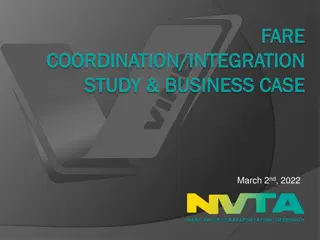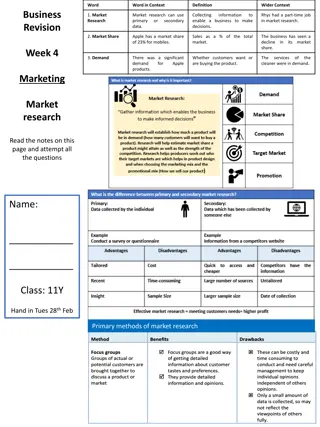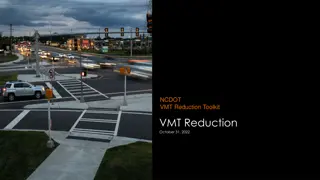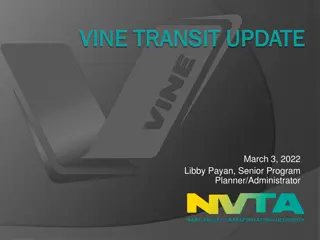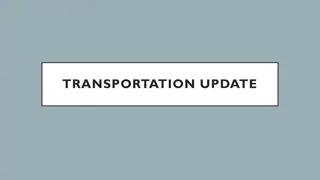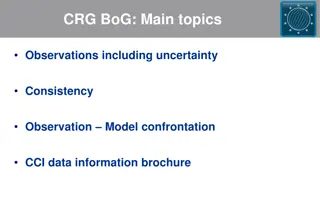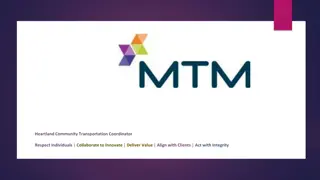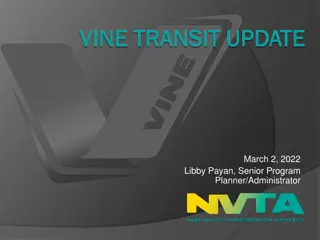
Insights on Ridership Trends & Market Observations
Uncover key insights into growing ridership trends and market observations. Explore little-known facts and intriguing data points on pedal bikes, electric bikes, and more. Discover commercial rules, sales patterns, and inventory levels to stay informed in the industry.
Download Presentation

Please find below an Image/Link to download the presentation.
The content on the website is provided AS IS for your information and personal use only. It may not be sold, licensed, or shared on other websites without obtaining consent from the author. If you encounter any issues during the download, it is possible that the publisher has removed the file from their server.
You are allowed to download the files provided on this website for personal or commercial use, subject to the condition that they are used lawfully. All files are the property of their respective owners.
The content on the website is provided AS IS for your information and personal use only. It may not be sold, licensed, or shared on other websites without obtaining consent from the author.
E N D
Presentation Transcript
GROWING GROWING RIDERSHIP RIDERSHIP
Lets Talk Let s Talk Where we are today Little known facts Key Insights Interesting observations from the data What to know What to do 13 Commercial rules
Where Where we are today (Pedal) we are today (Pedal)
Where Where we are today (Electric) we are today (Electric)
Little Known Facts.. Little Known Facts ..
Key Insights.. Key Insights ..
Key Insights.. Key Insights ..
Key Insights.. Key Insights ..
Key Insights.. Key Insights ..
Key Insights.. Key Insights ..
Pedal bike import units are down more than 6m from the 10 year average. Average import value for pedal bikes is up 30% USA assembly remains small with 350K of frames imports into the USA for sales, warranty, and local assembly My estimate is Ebike imports at 800K ~ 900K Estimate 60% are class 2, most sold D2C China remains a major source for 87% of all bikes Retail bike sell through is down year on year ASP at IBD is up to $1.4K (up 50% from 2017) Average retail for IBD s is 8.5x the Rest of Market (ROM) In 2017 in was 6.5x ROM Inventory levels within the channel for some categories is over 10 months Sales of OPP adult bikes (ATB, comfort, lifestyle leisure) are down significantly Children s bicycle sales are slowing P & A inventory levels at retail in many categories is 1 year or more. Likely P & A inventory at wholesale is also high The secondary market is strong Observations Observations from the data from the data
World Health Organization (WHO) data: Global physical activity among young adolescents has dropped TO 20% (post Covid) from 50%+ pre Covid. Global adult physical activity has also declined TO 57% (post Covid) and is trending downward. The WHO has set audacious goals to stimulate youth physical activity back up over 50% by 2030 and adult to over 60% Physical activity criteria are defined as: Adults Youth = = 150 minutes of physical activity weekly 70 minutes per day W What to know hat to know? ?
Making cycling safer: Building confidence, miles and local bike sales Increased Rider Confidence: As safety improves, more people are likely to invest in bikes, accessories, and gear. Target Sales Growth: Urban commuters, recreational riders, and families drawn by new infrastructure drive demand for various bike models, including ebikes. Building recurring revenue streams: Service packages, rentals, and safety gear sales rise alongside increased bike adoption. Infrastructure Development and Advocacy Dedicated Bike Lanes and Protected Routes: Work with city planners to advocate for physically separated bike lanes and trails to ensure safe commuting and recreational riding. Develop interconnected bike networks, including greenways and rail-to-trail conversions, for safe long-distance routes. Secure Parking Facilities: Support the installation of well-lit, secure bike racks and storage areas at workplaces, schools, and transit hubs. Community Mapping Tools: Provide digital maps showing low-traffic roads, bike lanes, and trails, making route planning easier for riders. Safety Equipment and Technology Visibility Enhancements: Promote products like high-visibility clothing, reflective gear, and LED lights to improve rider visibility. Smart Helmets and Safety Devices: Feature smart helmets with integrated lights, turn signals, and crash-detection (MIPS) technology. Offer mirrors, horn systems, and rearview radar devices to help cyclists feel safer in traffic. Community Engagement and Education Safety Workshops and Training Sessions: Host regular classes on safe riding techniques, road rules, and defensive cycling strategies. Offer youth-specific programs to instill safe habits early. Group Rides and Confidence-Building Events: Organize guided rides for beginners and families to help them build confidence while learning group riding etiquette. Collaborations with Schools and Workplaces: Establish bike-to-school, Bike Busses, Bike libraries and bike-to-work campaigns to normalize biking as a safe and convenient transportation mode. Bike-Friendly Business Certification Programs Work with municipalities to develop certification programs that encourage businesses to provide cyclist-friendly amenities (bike racks, repair stations, water refill stations). Promote businesses that support cycling, driving traffic to local shops and boosting sales. Rental Programs and Bike Trials Provide test rides of electric bikes and commuter models to address specific safety concerns like long commutes or hilly terrain.
Inclusivity: Building a Welcoming Community By focusing on inclusivity, representation, and accessibility, IBD s can become hubs for empowerment and community building while promoting cycling as a means of connection and mobility. Store Environment and Accessibility Physical Accessibility: Ensure the store layout accommodates wheelchairs and strollers and install ramps and automatic doors. Visual Representation: Feature diverse imagery in advertisements, posters, and product displays to reflect people of different races, genders, body types, and abilities. Welcoming Atmosphere: Train staff on cultural competency, inclusive language, and gender-neutral interactions to make everyone feel comfortable and respected. Workshops and Skill-Building Events Basic Bike Maintenance Classes: Offer free or low-cost classes for beginners, especially targeting underserved communities. Women Focused Events: Host women-only, focused events to foster safe learning environments. Youth Programs: Engage young riders with programs focusing on bike safety, repair skills, and environmental awareness. Community Partnerships Collaborate with Local Organizations: Partner with schools, cultural centers, and advocacy groups to promote cycling education and support outreach efforts. Sponsor Group Rides and Meetups: Organize group rides for different communities (e.g., women riders, performance groups, casual cyclists, veterans) to build camaraderie and visibility. Representation in Leadership and Staff Mentorship Programs: Support underserved voices by training individuals from underrepresented groups to become bike mechanics, guides, or instructors. Financial Accessibility Sliding Scale Pricing: Offer affordable pricing or installment plans for bikes and accessories to increase access. Scholarships and Sponsorships: Provide funding and in-kind product for youth programs, cycling camps, and leadership training. Storytelling and Advocacy Highlight Diverse Stories: Use newsletters, social media, and blogs to amplify voices of underrepresented cyclists and share inspiring journeys. Advocate for Policy Change: Work with city officials and bike coalitions to improve infrastructure and ensure safe cycling routes in underserved areas.
Breaking Barriers: Making Cycling More Accessible Attract price-sensitive customers who may later invest in upgrades or accessories. Build trust and loyalty by serving as a community resource. Expand market reach by catering to new riders and underserved groups. Drive recurring revenue through repair services, accessories, and workshops. Affordable Pricing Options Offer Used or Refurbished Bikes: Establish trade-in programs where customers can exchange old bikes for store credit, enabling resale of affordable, refurbished models. Flexible Payment Plans: Provide installment financing or "rent-to-own" programs to help customers spread out payments. Collaborate with financing companies to create interest-free payment options. Discount Programs: Offer discounts for students, seniors, and low-income families. Create incentive programs for bike commuters to encourage regular use. Repair and Maintenance Support DIY Repair Workshops: Host free or low-cost maintenance clinics to teach essential skills like fixing flat tires, adjusting brakes, and lubricating chains. Offer open shop hours where customers can use store tools and workstations under staff supervision. Community Tool Libraries: Create a tool lending library, allowing riders to borrow tools and repair kits rather than purchasing them. On-the-Go Repair Stations: Sponsor public bike repair stations with basic tools and pumps in key cycling areas. Technology Education and Support Demystify Ebikes and Smart Accessories: Offer test rides and demos to help customers understand ebike systems, battery life, and features. Provide one-on-one consultations for integrating smart safety devices, GPS systems, and fitness trackers. Bike Rental and Maintenance Programs Rental Services: Offer short-term rentals to make cycling accessible without upfront costs. Include ebike rental options to cater to commuters and those with physical limitations. Subscription Models: Provide monthly bike subscription plans with maintenance included, allowing flexible ownership options. Community Outreach and Partnerships School and Youth Programs: Create partnerships with schools to provide bikes, helmets, and safety lessons for students. Employer Partnerships: Work with local businesses to launch bike-to-work programs with discounts or incentives for employees Product Bundles and Entry-Level Models Starter Kits: Sell affordable starter bundles, including basic bikes, helmets, locks, and lights, to reduce initial investment barriers. Entry-Level Models: Stock budget-friendly bikes for first-time riders, families, and recreational users, while also promoting trade-up programs as skills grow. Marketing and Education Campaigns Inclusive Messaging: Feature diverse riders in marketing materials to make cycling feel welcoming for all ages, genders, and income levels
I. Be humble, honest, transparent and authentic in everything you do. Respect the customers are ALWAYS right. III. Respond and resolve issues immediately. IV. Seek perfection in each customer transaction. V. Embrace and be pro-active with social media. VI. Manage customer reviews to protect your business and brand. VII. Constantly adapt and adjust to changing customer behavior. VIII.Invest in technology to simplify transactions. IX. Embrace customer feedback. X. Adapt a missionary attitude and avoid mercenary actions. XI. Recognize and reward outstanding behavior. XII. Learn, un-learn, and re-learn. XIII.Innovate, innovate and innovate more. II. Adapt the 13 commercial rules for success
Thanks for the opportunity to share Thanks for the opportunity to share learning and experiences learning and experiences Bmargevicius@specialized.com +1-408-607-9499


